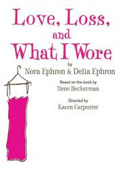Delia Ephron: Memories of Purses Past in Love, Loss, and What I Wore
About the author:
As a writer, Delia Ephron defies classification and has the rare ability to appeal to every age group. Fiction, nonfiction, humor, screenwriting, playwriting—Ephron’s done it all with great success, both on her own (her bestseller-turned-musical How to Eat Like a Child; the screenplay for The Sisterhood of the Traveling Pants) and in partnership with her sister Nora (screenplays for You’ve Got Mail, This Is My Life and more). Now the gifted Ephrons have teamed up to create an exciting evening of monologues, Love, Loss, and What I Wore, which opens off-Broadway at the Westside Theatre on October 1. How did this starry show come together? Ephron tells all.![]()
Love, Loss, and What I Wore began as a book, a small but powerful best-selling memoir by Ilene Beckerman. With minimal text and amazingly evocative naive drawings, Ilene Beckerman told the story of her life.
My sister Nora read it, fell in love with it, and passed it on to me. What we especially loved was that, even though our lives were nothing like Ilene Beckerman’s or our clothes, the minute we read the book, we started thinking about our own clothes and our own lives.
What we wore when…clothes are a trigger for remembering the most emotional, funny, romantic and heartbreaking times of our lives. I suspect this is totally a girl thing; it’s women and clothes, men and cars. In any event, Love, Loss, and What I Wore seemed perfect for the theater—a kind of vagina monologues without the vaginas.
We asked friends and friends of friends to tell us stories about themselves and their clothes. We interviewed and sent out e-mail questionnaires. Information poured in, about bras and prom dresses, letter sweaters, gang sweaters, cowboy boots, wedding dresses. Stories of what we wore when we fell in love and when we broke up. What our mothers bought us, told us and scolded us about clothes.
From the material, we culled the stories that seemed to work best and that complimented Ilene’s story, sometimes built them into bigger pieces or combined them. What resulted is the play Love, Loss, and What I Wore, an evening of clothes and memories—monologues and ensemble pieces performed by five female actors. There’s the tale of cowboy boots that becomes the story of a woman who wasted her twenties on the wrong man, Nora’s rant on purses and how much she hates them, life in the fatter lane and the thinner lane, marriage, divorce, Madonna, Birkenstocks, and much more. Of course we’ve included an ode to black. Would we be New York women if we didn’t love black?
Thanks to Karen Carpenter, our director, we had a workshop and reading in the summer of 2008 at Guild Hall in East Hampton, and then Daryl Roth offered us a wonderful opportunity: to hold a series of readings on Monday nights at the DR2, her theater near Union Square, benefiting the charity Dress for Success. Our actors came in the morning, rehearsed all day, and performed that night. We were fortunate to have extraordinary actors, many of whom are joining us this fall when, thanks to Daryl, we begin our run at the Westside Theatre.
The cast for the off-Broadway production includes actors I’ve dreamed of working with, and in some cases have been lucky enough to work with before: Samantha Bee, Mary Birdsong, Kristin Chenoweth, Tyne Daly, Lucy DeVito, Capathia Jenkins, Lisa Joyce, Jane Lynch, Natasha Lyonne, Rosie O’Donnell, Rhea Perlman, Mary Louise Wilson, and Rita Wilson. We have three casts, one a month for three months. Once again, a portion of the proceeds will go to Dress for Success, a charity that provides clothes and job support for low-income women. People attending are invited to donate their gently used purses, belts and accessories. They’ll be collected in the lobby.
During our tryout last fall, we noticed, happily, that the audience didn’t want to leave the lobby because they were too busy talking about their own clothes, like the falsies that ended up floating in the swimming pool, or a polka dot dress stolen from a sister (subsequently ruined at a rock concert), or Easter dresses bought by Dad. When we open in October, audience members will have the opportunity to draw a dress of their own. We’ll display drawings in the lobby, which will become a gallery of our collective memories.
